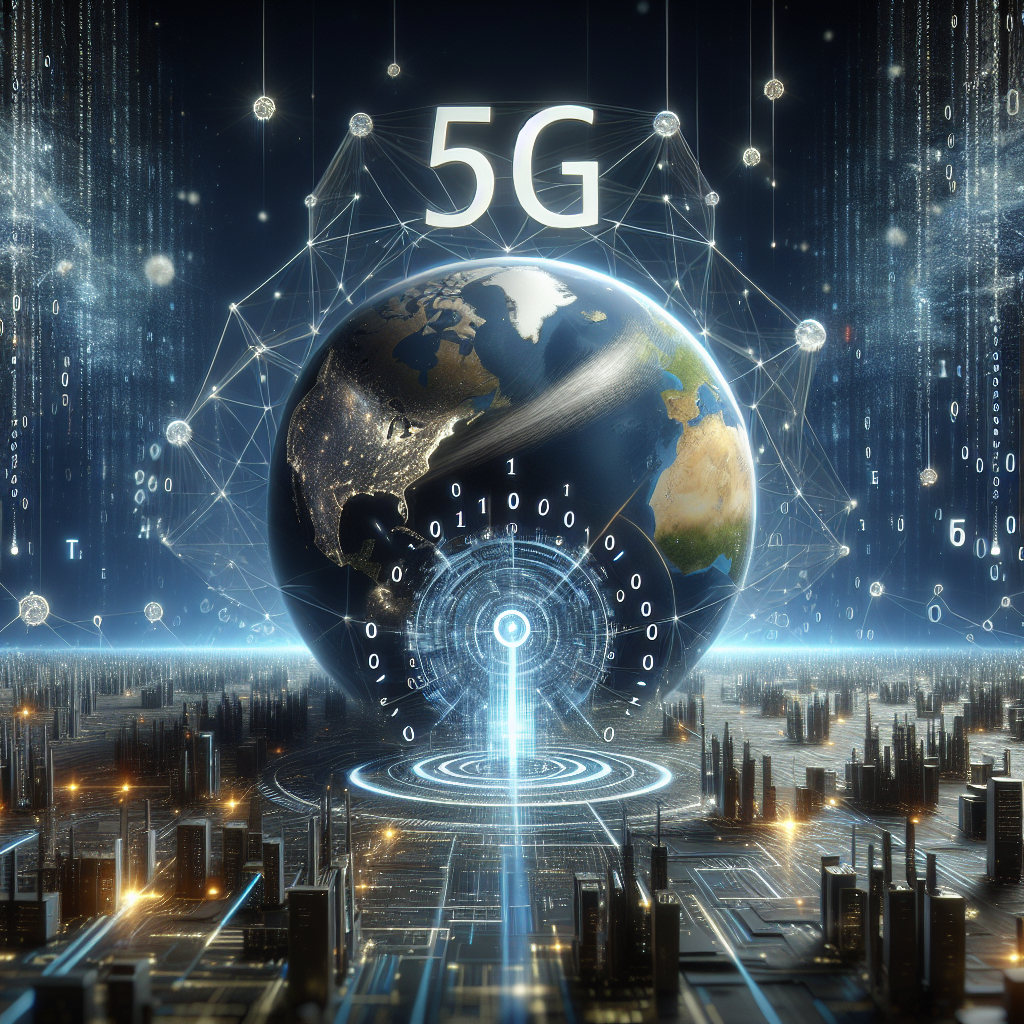In our rapidly evolving digital landscape, the emergence of 5G network edge computing is set to revolutionize the way we connect and interact with the world around us. By leveraging the power of ultra-fast 5G networks and decentralized computing at the edge of the network, businesses and individuals alike can expect lightning-fast data processing, reduced latency, and enhanced security for a seamless user experience. This cutting-edge technology is not only changing the way we access information but also facilitating the development of innovative applications such as autonomous vehicles, smart cities, and augmented reality. Join us as we delve into the exciting possibilities that 5G network edge computing holds for the future of connectivity.
5G network edge computing will revolutionize our digital world by providing ultra-low latency, high bandwidth, and decentralized processing power. This will enable seamless connectivity for IoT devices, autonomous vehicles, AR/VR applications, and more, transforming industries such as healthcare, transportation, and entertainment. The edge computing capabilities of 5G will not only enhance user experience but also drive innovation and efficiency in various sectors, paving the way for a more connected and intelligent future.
Understanding 5G Network Edge Computing
Definition and Basics of Edge Computing
Edge computing is a distributed computing paradigm that brings computation and data storage closer to the location where it is needed, improving response times and saving bandwidth. In the context of 5G networks, edge computing involves processing data at the edge of the network, closer to where it is generated, rather than relying on a centralized data center. This enables real-time data processing, reducing latency and enhancing overall network performance.
Evolution of 5G Networks and Its Impact on Edge Computing
The evolution of 5G networks has been a crucial driver in the advancement of edge computing. With its high data speeds, low latency, and ability to support a massive number of connected devices, 5G enables the seamless integration of edge computing into the network infrastructure. This integration allows for a wide range of applications, from autonomous vehicles to smart cities, that require real-time processing and decision-making capabilities at the network edge. By leveraging the power of 5G, edge computing is poised to revolutionize the way data is handled, processed, and delivered in our increasingly connected digital world.
Benefits of Implementing 5G Network Edge Computing
-
Enhanced Network Speed and Lower Latency
5G network edge computing offers enhanced network speed by reducing the time it takes for data to travel between devices and servers. By processing data closer to the edge of the network, latency is significantly reduced, enabling real-time interactions and seamless user experiences. This improved speed is crucial for applications like autonomous vehicles, augmented reality, and smart cities, where split-second decisions are vital.
-
Improved Data Security and Privacy
With 5G network edge computing, data processing occurs closer to the source, reducing the need to transmit sensitive information over long distances. This proximity enhances data security and privacy by minimizing the exposure of data to potential breaches during transit. By keeping sensitive data localized, organizations can better protect their information and comply with stringent privacy regulations.
-
Scalability and Flexibility in Network Infrastructure
5G network edge computing allows for greater scalability and flexibility in network infrastructure by distributing computational resources geographically. This distributed architecture enables organizations to dynamically allocate resources based on demand, optimizing performance and cost-effectiveness. Additionally, edge computing facilitates the deployment of new services and applications rapidly, without the need for extensive network redesigns. This scalability and flexibility are essential for accommodating the evolving needs of modern digital ecosystems.
5G Network Edge Computing offers enhanced network speed, lower latency, improved data security, scalability, and flexibility in network infrastructure. It enables real-time processing, decision-making, and applications like smart cities, autonomous vehicles, and healthcare systems. Overcoming challenges like bandwidth limitations, compatibility with existing network architectures, and edge device management is crucial for successful implementation. Future trends include the integration of blockchain technology for security, network slicing, and collaborative edge computing models. The implications of 5G Network Edge Computing are significant, closing the digital divide, transforming industries, and requiring policy and regulatory considerations for successful adoption.
Implementation Challenges and Solutions

Overcoming Bandwidth Limitations at the Edge
- Bandwidth constraints at the edge pose a significant challenge for 5G network edge computing. The limited capacity for data transfer between edge devices and the cloud can hinder the seamless operation of applications requiring real-time data processing.
- Solution: One approach to address this challenge is to implement edge caching mechanisms. By storing frequently accessed data closer to the edge devices, latency can be reduced, and bandwidth usage optimized. This ensures that critical data is readily available without overwhelming the network.
Ensuring Compatibility with Existing Network Architectures
- The integration of 5G network edge computing with legacy network infrastructures can present compatibility issues. Ensuring a smooth transition to a hybrid network environment is crucial for maximizing the benefits of edge computing.
- Solution: Employing network slicing technology allows service providers to create customized virtual networks within the existing infrastructure. This enables the allocation of resources based on specific requirements, ensuring compatibility and efficient utilization of network resources.
Addressing Concerns Related to Edge Device Management
- Managing a large number of edge devices distributed across a wide geographical area introduces complexities in monitoring, maintenance, and security. Ensuring the reliability and security of edge devices is essential for the successful deployment of 5G network edge computing.
- Solution: Implementing edge orchestration platforms can streamline device management processes by automating provisioning, configuration, and monitoring tasks. These platforms enable centralized control and visibility over edge devices, enhancing operational efficiency and security measures.
Real-World Applications of 5G Network Edge Computing
Smart Cities and IoT Integration
The integration of 5G network edge computing in smart cities is poised to revolutionize urban living. By leveraging ultra-low latency and high bandwidth capabilities at the edge, municipalities can enhance public services, optimize traffic flow, and improve overall operational efficiency. Through real-time data processing and analysis at the edge, smart city infrastructure such as surveillance systems, traffic lights, and environmental sensors can respond instantaneously to changing conditions, leading to safer and more sustainable urban environments.
Edge AI and Machine Learning Capabilities
The convergence of 5G network edge computing with artificial intelligence (AI) and machine learning technologies opens up a myriad of possibilities across various industries. By deploying AI algorithms at the network edge, organizations can achieve faster decision-making, improved data security, and enhanced user experiences. In sectors like manufacturing, retail, and finance, edge AI enables predictive maintenance, personalized recommendations, and fraud detection in real time, empowering businesses to operate more efficiently and competitively in the digital landscape.
Edge Computing in Autonomous Vehicles and Healthcare Systems
5G network edge computing plays a crucial role in advancing autonomous vehicles and healthcare systems to new levels of performance and reliability. By processing data closer to the source – be it a self-driving car or a medical device – edge computing reduces latency and ensures rapid response times critical for ensuring passenger safety and delivering timely medical interventions. In autonomous vehicles, edge computing enables real-time decision-making based on sensor data, while in healthcare, it facilitates remote patient monitoring, telemedicine services, and predictive diagnostics, ultimately improving healthcare accessibility and outcomes.

Future Trends and Innovations in 5G Network Edge Computing
As technology continues to advance, the future of connectivity lies in the evolution of 5G network edge computing. This cutting-edge technology is set to revolutionize the way we interact with the digital world, offering faster speeds, lower latency, and improved reliability. Let’s delve into some of the key trends and innovations that are shaping the future of 5G network edge computing:
-
Integration of Blockchain Technology for Enhanced Security
In an increasingly interconnected world, security remains a top priority for businesses and consumers alike. One of the emerging trends in 5G network edge computing is the integration of blockchain technology to enhance security measures. By leveraging the decentralized and immutable nature of blockchain, organizations can ensure secure and transparent transactions across the network. This innovative approach not only bolsters cybersecurity but also enables secure data sharing and storage in the digital ecosystem.
-
Edge Computing in 5G Network Slicing and Network Slicing as a Service
5G network slicing is revolutionizing the way network resources are allocated and utilized. By dividing a single physical network into multiple virtual networks, each tailored to specific applications or users, network slicing enables efficient resource management and customization. Moreover, the concept of Network Slicing as a Service (NSaaS) is gaining traction, allowing businesses to dynamically provision and manage network slices on-demand. This flexible and scalable approach to network management is set to drive innovation across industries, from healthcare to manufacturing.
-
Collaborative Edge Computing Models and Interoperability Standards

Collaborative edge computing models are reshaping the digital landscape by enabling seamless integration and communication between edge devices and cloud infrastructure. By distributing computing resources closer to the point of data generation, collaborative edge computing minimizes latency and enhances real-time data processing capabilities. Furthermore, the development of interoperability standards is essential for ensuring compatibility and connectivity between diverse edge devices and networks. As the ecosystem of connected devices continues to expand, interoperability standards will play a crucial role in driving innovation and facilitating cross-platform communication.
Implications of 5G Network Edge Computing on Global Connectivity
The integration of 5G network edge computing is set to revolutionize global connectivity, bringing about significant implications for various aspects of society and industry. As this cutting-edge technology becomes more widespread, its impact is expected to be profound and far-reaching.
- Closing the Digital Divide in Underserved Regions
5G network edge computing has the potential to bridge the digital gap in underserved regions by providing faster and more reliable connectivity. By moving computing resources closer to the network edge, data processing and communication can be expedited, enabling better access to online services and information in remote areas. This can lead to enhanced educational opportunities, improved healthcare services, and increased economic development in regions that were previously marginalized due to connectivity issues.
- Impact on Industries such as Manufacturing, Retail, and Telecommunications
The implementation of 5G network edge computing is poised to transform industries such as manufacturing, retail, and telecommunications by enabling real-time data processing and analysis at the edge of the network. In manufacturing, for example, edge computing in 5G networks can facilitate the deployment of smart factories with automated processes and predictive maintenance capabilities. Similarly, in retail, edge computing can enhance customer experiences through personalized services and efficient inventory management. Moreover, in the telecommunications sector, edge computing in 5G networks can enable faster data transmission, lower latency, and support the proliferation of IoT devices, paving the way for innovative services and applications.
- Policy and Regulatory Considerations for the Adoption of Edge Computing in 5G Networks
As the deployment of 5G network edge computing accelerates, policymakers and regulators face the challenge of establishing frameworks that ensure the efficient and secure operation of these advanced networks. Issues such as data privacy, cybersecurity, and network interoperability need to be carefully addressed to harness the full potential of edge computing in 5G networks. Moreover, regulations related to spectrum allocation, infrastructure development, and industry standards play a crucial role in shaping the future landscape of connectivity and digital transformation. Collaboration between governments, industry stakeholders, and technology providers is essential to create a conducive environment for the successful adoption of edge computing in 5G networks.
FAQs for Exploring the Future of Connectivity: How Will 5G Network Edge Computing Shape Our Digital World?
What is 5G network edge computing?
5G network edge computing combines the power of 5G wireless technology with edge computing infrastructure. Edge computing brings data processing closer to where it is generated, reducing latency and improving overall network performance. This innovative approach allows for faster data processing and enables new applications and services that were not possible with previous generations of wireless technology.
How will 5G network edge computing benefit our digital world?
5G network edge computing will bring numerous benefits to our digital world. By reducing latency and enabling faster data processing, it will improve the performance of applications such as virtual reality, augmented reality, autonomous vehicles, and more. Additionally, it will enable real-time data analysis and decision-making, leading to increased efficiency and productivity across various industries.
What are some examples of 5G network edge computing implementations?
Some examples of 5G network edge computing implementations include smart city solutions, where real-time data processing is used to optimize traffic flow and improve public services. Additionally, in the healthcare industry, edge computing can enable remote patient monitoring and quicker access to medical records. In the manufacturing sector, edge computing can be used to improve the efficiency of production lines and reduce downtime.
How does 5G network edge computing address security concerns?
5G network edge computing introduces new security challenges, but also provides innovative solutions to address them. By processing data closer to where it is generated, edge computing can reduce the risk of data breaches during transit. Furthermore, edge computing allows for the implementation of security measures such as encryption, authentication, and access control at the edge of the network, providing an additional layer of protection for sensitive data.
How can businesses leverage 5G network edge computing for competitive advantage?
Businesses can leverage 5G network edge computing to gain a competitive advantage in various ways. By utilizing edge computing to enable real-time data analysis and decision-making, businesses can become more agile and responsive to changing market conditions. Additionally, edge computing can support the development of innovative products and services that differentiate them from competitors. Overall, embracing 5G network edge computing can help businesses stay ahead in an increasingly digital and connected world.